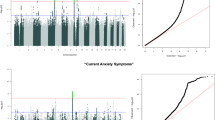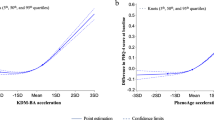Abstract
Anxiety symptoms are common in later life and are associated with diverse adverse health outcomes. Little is known about how genetic and environmental influences on anxiety symptoms might vary across older adulthood. The purpose of this study was to explore change and stability of contributions to anxiety symptoms across older adulthood. We examined data from the Swedish Adoption/Twin Study of Aging (SATSA). Between the years 1984 and 2010, 2021 participants (including 753 complete twin pairs) completed up to seven assessments containing two measures of anxiety symptoms. Longitudinal genetic simplex models were fit to examine the stability and change in genetic and environmental influences. Amplification of genetic factors at ages 75–80 suggests tentative new genetic contributions to anxiety symptoms. These findings suggest that the heritability of anxiety symptoms may increase later in life. Physiological factors associated with aging are discussed as potential factors explaining this increase.





Similar content being viewed by others
References
Beaudreau SA, O’Hara R (2008) Late-life anxiety and cognitive impairment: a review. Am J Geriatr Psychiatr 16:790–803
Beaudreau S, MacKay-Brandt A, Reynolds J (2013) Application of a cognitive neuroscience perspective of cognitive control to late-life anxiety. J Anxiety Disord 27:559–566
Boker S, Neale M, Maes HH, Wilde M, Spiegel M, Brick T, Spies J, Estabrook R, Kenny S, Bates T, Mehta P, Fox J (2011) OpenMx: an open source extended structural equation modeling framework. Psychometricka 76:306–317
Bond TG, Fox CM (2007) Applying the Rasch model: fundamental measurement in the human sciences. Lawrence Erlbaum Associates, Mahwah
Boomsma DI, Martin NG, Molenaar PC (1989) Factor and simplex models for repeated measures: application to two psychomotor measures of alcohol sensitivity in twins. Behav Genet 19:79–96
Braam AW, Copeland JR, Delespaul PA, Beekman AT, Como A, Dewey M, Fichter M, Holwerda TJ, Lawlor BA, Lobo A, Magnusson H, Prince MJ, Reischies F, Wilson KC, Skoog I (2014) Depression, subthreshold depression and comorbid anxiety symptoms in older Europeans: results from the EURODEP concerted action. J Affect Disord 155:266–272
Brenes GA, Penninx BW, Judd PH, Rockwell E, Sewell DD, Wetherell JL (2008) Anxiety, depression and disability across the lifespan. Aging Ment Health 12:158–163
Carmelli D, Swan GE, Kelly-Hayes M, Wolf PA, Reed T, Miller B (2000) Longitudinal changes in the contribution of genetic and environmental influences to symptoms of depression in older male twins. Psychol Aging 15:505–510
Cederlof R, Lorich U (1978) The Swedish twin registry. Prog Clin Biol Res 24:189–195
Chou KL (2009) Age at onset of generalized anxiety disorder in older adults. Am J Geriatic Psychiatry 17:455–464
Enders CK, Bandalos DL (2001) The relative performance of full information maximum likelihood estimation for missing data in structural equation models. Struct Equ Model 8:430–457
Eysenck HJ, Eysenck SBG (1968) Manual for the Eysenck personality inventory. Educational and Industrial Testing Service, San Diego
Finkel D, Pedersen NL (2004) Processing speed and longitudinal trajectories of change for cognitive abilities: the Swedish Adoption/Twin Study of Aging. Aging Neuropsychol Cognit 11:325–345
Gatz M, Pedersen NL, Plomin R, Nesselroade JR, McClearn GE (1992) Importance of shared genes and shared environments for symptoms of depression in older adults. J Abnorm Psychol 101:701–708
Gibbons L, Teri L, Logsdon R, McCurry S, Kukull W, Bowen J, McCormick W, Larson E (2002) Anxiety symptoms as predictors of nursing home placement in patients with Alzheimer’s disease. J Clin Geropsychology 8:335–342
Gillespie NA, Kirk KM, Evans DM, Heath AC, Hickie IB, Martin NG (2004) Do the genetic or environmental determinants of anxiety and depression change with age? A longitudinal study of Australian twins. Twin Res Hum Genet 7:39–53
Goncalves DC, Byrne GJ (2012) Sooner or later: age at onset of generalized anxiety disorder in older adults. Depress Anxiety 29:39–46
Hettema JM, Prescott CA, Myers JM, Neale MC, Kendler KS (2005) The structure of genetic and environmental risk factors for anxiety disorders in men and women. Arch Gen Psychiatry 62:182–189
Johnson W, McGue M, Gaist D, Vaupel JW, Christensen K (2002) Frequency and heritability of depression symptomatology in the second half of life: evidence from Danish twins over 45. Psychol Med 32:1175–1185
Kendler KS, Heath A, Martin NG, Eaves LJ (1986) Symptoms of anxiety and depression in a volunteer twin population. The etiologic role of genetic and environmental factors. Arch Gen Psychiatry 43:213–221
Kendler KS, Heath AC, Martin NG, Eaves LJ (1987) Symptoms of anxiety and symptoms of depression. Same genes, different environments? Arch Gen Psychiatry 44:451–457
Kendler KS, Aggen SH, Knudsen GP, Roysamb E, Neale MC, Reichborn-Kjennerud T (2011) The structure of genetic and environmental risk factors for syndromal and subsyndromal common DSM-IV axis I and all axis II disorders. Am J Psychiatry 168:29–39
Kessler RC, Berglund P, Demler O, Jin R, Merikangas KR, Walters EE (2005) Lifetime prevalence and age-of-onset distributions of DSM-IV disorders in the National Comorbidity Survey Replication. Arch Gen Psychiatry 62:593–602
Le Roux H, Gatz M, Wetherell JL (2005) Age at onset of generalized anxiety disorder in older adults. Am J Geriatr Psychiatr 13:23–30
Losada A, Marquez-Gonzalez M, Pachana NA, Wetherell JL, Fernandez-Fernandez V, Nogales-Gonzalez C, Ruiz-Diaz M (2014) Behavioral correlates of anxiety in well-functioning older adults. Int Psychogeriatr 27:1135–1146
McGue M, Bouchard TJ (1984) Adjustment of twin data for the effects of age and sex. Behav Genet 14:325–343
McGue M, Christensen K (2003) The heritability of depression symptoms in elderly Danish twins: occasion-specific versus general effects. Behav Genet 33:83–93
McGue M, Christensen K (2013) Growing old but not growing apart: twin similarity in the latter half of the lifespan. Behav Genet 43:1–12
Ormel J, Rijsdijk F (2000) Continuing change in neuroticism during adulthood- Structural modeling of a 16-year 5-wave community study. Personal Individ Differ 28:461–478
Pedersen NL, McClearn GE, Plomin R, Nesselroade JR, Berg S, deFaire U (1991) The Swedish Adoption Twin Study of Aging: an update. Acta Genet Med Gemollol 40:7–20
Pederson NL, Reynolds CA (1998) Stability and change in adult personality: genetic and environmental components. Eur J Personal 12:365–386
Porensky EK, Dew MA, Karp JF, Skidmore E, Rollman BL, Shear MK, Lenze EJ (2009) The burden of late-life generalized anxiety disorder: effects on disability, health-related quality of life, and healthcare utilization. Am J Geriatr Psychiatr 17:473–482
Potvin O, Bergua V, Meillon C, Le Goff M, Bouisson J, Dartigues JF, Amieva H (2011) Norms and associated factors of the STAI-Y State anxiety inventory in older adults: Results from the PAQUID study. Int Psychoger 23:869–879
Rodrigues R, Petersen RB, Perry G (2014) Parallels between major depressive disorder and Alzheimer’s disease: role of oxidative stress and genetic vulnerability. Cell Mol Neurobiol 34:925–949
Salthouse TA (2010) Selective review of cognitive aging. J Int Neuropsychol Soc 16:754–760
Schmitz S, Cherny SS, Fulker DW (1998) Increase in power through multivariate analyses. Behav Genet 28:357–363
Spielberger CD (1979) Preliminary manual for the state-trait personality inventory (STPI). University of South Florida, Tampa
Van Orden KA, Simning A, Conwell Y, Skoog I, Waern M (2013) Characteristics and comorbid symptoms of older adults reporting death ideation. Am J Geriatr Psychiatr 21:803–810
Wetherell JL, Gatz M, Pedersen NL (2001) A longitudinal analysis of anxiety and depressive symptoms. Psychol Aging 16:187–195
Wolitzky-Taylor KB, Castriotta N, Lenze EJ, Stanley MA, Craske MG (2010) Anxiety disorders in older adults: a comprehensive review. Depress Anxiety 27:190–211
Zhang X, Norton J, Carriere I, Ritchie K, Chaudieu I, Ancelin ML (2015) Risk factors for late-onset generalized anxiety disorder: results from a 12-year prospective cohort (the ESPRIT study). Transl Psychiatr 5:e536
Acknowledgments
SATSA was supported by Grants R01 AG04563, R01 AG10175, the MacArthur Foundation Research Network on Successful Aging, the Swedish Council For Working Life and Social Research (FAS) (97:0147:1B, 2009-0795) and Swedish Research Council (825-2007-7460, 825-2009-6141). Dr. Petkus was partially supported by a Ruth L. Kirschstein National Research Service Award (NRSA) fellowship awarded by the National Institute on Aging (1F31AG042218-01).
Author information
Authors and Affiliations
Corresponding author
Ethics declarations
Conflict of Interest
The authors have no conflict of interest.
Human Rights and Informed Consent
Participants provided written informed consent to participate in the study. This study was approved by the Institutional Review Board at the Karolinksa Institutet and the University of Southern California. All participants were treated in accordance with the Declaration of Helsinki.
Additional information
Edited by Michael Lyons
Rights and permissions
About this article
Cite this article
Petkus, A.J., Gatz, M., Reynolds, C.A. et al. Stability of Genetic and Environmental Contributions to Anxiety Symptoms in Older Adulthood. Behav Genet 46, 492–505 (2016). https://doi.org/10.1007/s10519-015-9772-0
Received:
Accepted:
Published:
Issue Date:
DOI: https://doi.org/10.1007/s10519-015-9772-0




